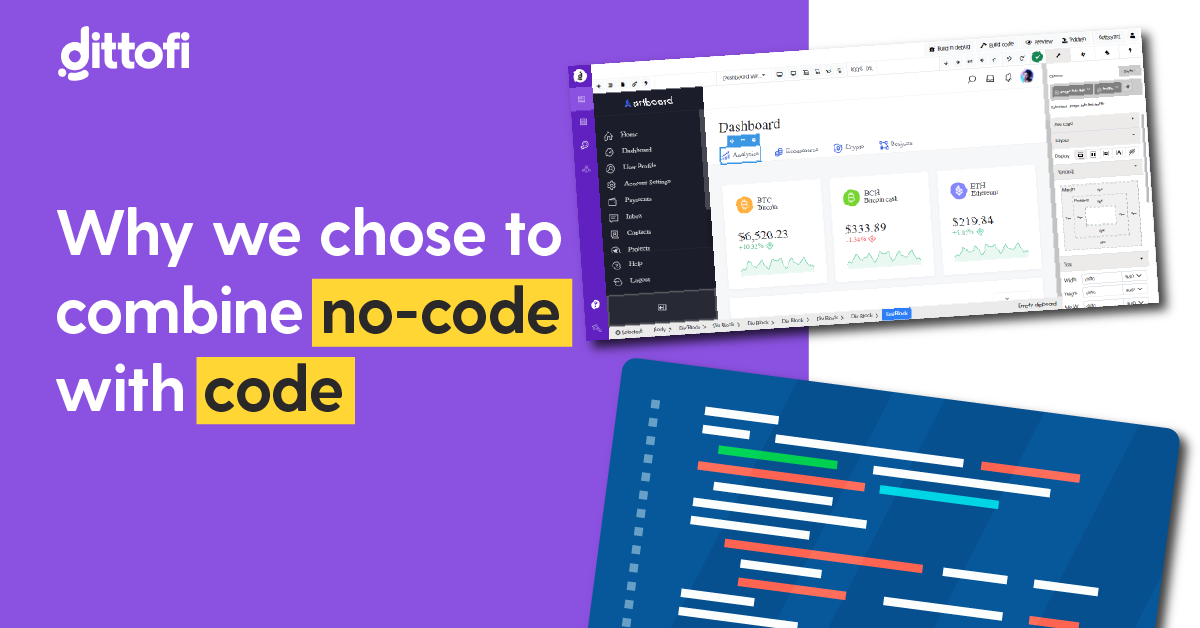To understand what hybrid no code is, you first need to know what no code and low code are.
No code and low code are visual app development tools – think graphical user interfaces, drag and drop, point and click and zero or at least very little code. These solutions are great because they drastically speed up app development. Without code however, the apps that these tools churn out are shockingly limited and, if the apps get big enough, they always need to be rebuilt with code.
Hybrid no code improves on the no code / low code model. It does this by supporting both visual app development and traditional coding. The hybrid approach enables developers and business users to build high tech apps in a user-friendly visual editor that transforms designs into actual code. Developers can then access this code for heavy duty customization while business users continue to work in the visual environment. The result? Organizations get highly valued and heavily custom apps into production 600% faster, without losing control over their apps source code.
In this article we are going to cover.
What is hybrid no code?
A hybrid no code platform automates much of the mundane tasks associated with app development. Using these tools, developers and business users are able to build apps visually and generate clean, reliable and scalable code that is automatically documented and can be deployed in a single click.
Although apps are built in visual environments, hybrid solutions also integrate directly into developer environments. This is so that professional developers can adjust algorithms at the app’s core, whilst the rest of the team continues to work in the visual environment. Hybrid no code platforms therefore democratize and speed up app development, without losing any of the fine-tune control of traditional app development.
Hybrid no code features
Easy to install pre-built and customizable back-end services and integrations.
Functionality to generate code in debug or release, automated deployment solutions to push code into test, staging or production systems and automatically documented code.
On demand access to code directly inside local developer environments.
Tools to generate code with the use of artificial intelligence. AI written code is typically more efficient and reliable than code written by hand.
Why is hybrid no code becoming popular?
No one doubts that to stay competitive companies need to invest in technology. However, a global developer shortage has put strain on existing IT teams. Developers are now expected to deliver new, sophisticated applications in increasingly shorter timelines while also maintaining, managing, and evolving the existing app portfolio.
Hybrid no code solutions solve this problem by automating much of the mundane tasks associated with app development. Using these tools, developers and business users are able to build apps visually and generate clean, reliable and scalable code that is automatically documented and can be deployed in a single click.
Although apps are built in visual environments, hybrid solutions also integrate directly into developer environments. This is so that professional developers can adjust algorithms at the app’s core, whilst the rest of the team continues to work in the visual environment. Hybrid no code platforms therefore democratize and speed up app development, without losing any of the fine-tune control of traditional app development.
“The global shortage of full-time developers will increase from 1.4 million in 2021 to 4.0 million in 2025, which means that the full-time developer labor force will perform 90.8% capacity in 2021 and 84.9% capacity in 2025.”
IDC, Quantifying the Worldwide Shortage of Full-Time Developers
The major benefits of hybrid no code include:
With hybrid no code development teams do not need to start their development from scratch. They can use collections of customizable app templates, UI components, back-end services, integrations and data models to fast track their app development.
Hybrid solutions bypass complex code and syntax so that even non-technical users can create applications. This makes hybrid no code compelling not only from a tactical standpoint, but also from a strategic one. In fact, according to KPMG 100% of organizations say that visual app development generated them a positive ROI.
Hybrid no code automates much of the code development process. The platforms generate clean, reliable and scalable code that is automatically documented, tested and is maintained by the hybrid no code vendor.
Using AI assistants, non-technical users are able to generate snippets of SQL, entire database structures & blocks of functional code from inside the visual app builder. This code integrates with developer tools where engineers can read, edit and update this code.
Who are the hybrid no code developers?
Anyone can learn how to build apps using hybrid no code tools, however the time it takes to train depends on your technical background. At Dittofi we have the following data points:
- Entirely non-technical – first time app builders – 30 hours of training
- Semi technical product developers – 10 hours of training
- Professional developers – less than 5 hours training
In all cases, users tend to appreciate ongoing support programs either free community or vendor supplied 8×5 / 24×7 support.
Key to selecting a platform for you is that you examine the platform’s education framework.
When you’re doing this, bear in mind that it does help to understand fundamental developer concepts such as client and server architecture, variables or even the box-model for front-end development. Therefore, if you are considering hybrid no code for a non-technical team, we recommend that you choose a platform that has different courses levels that range from beginner to expert.
Try Hybrid No Code Now
Sign up to Dittofi’s Hybrid No Code platform
14 day free trial (no credit card)

